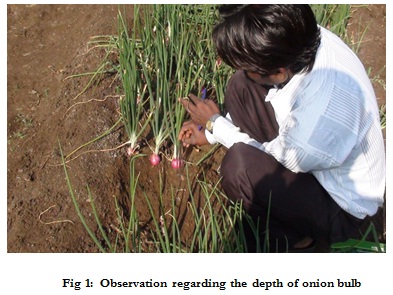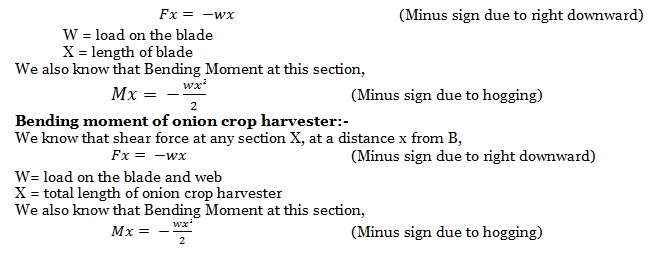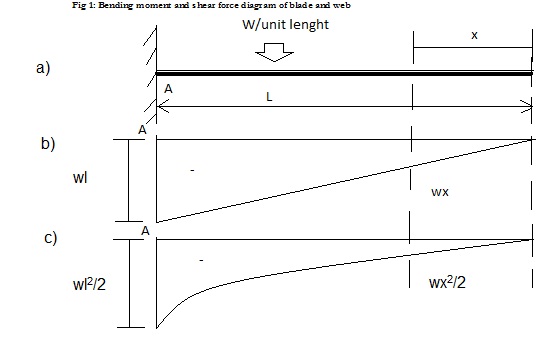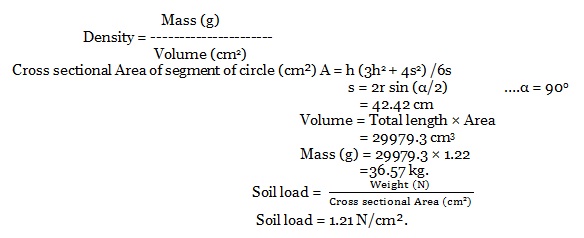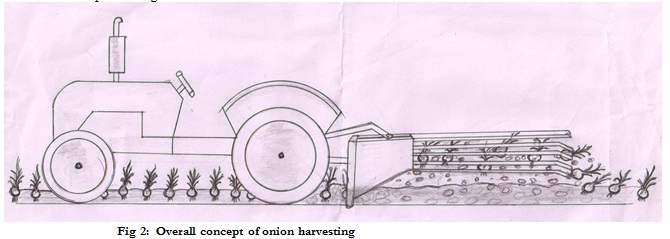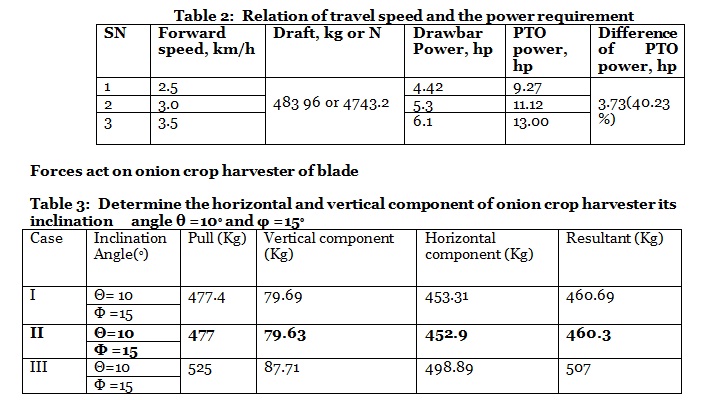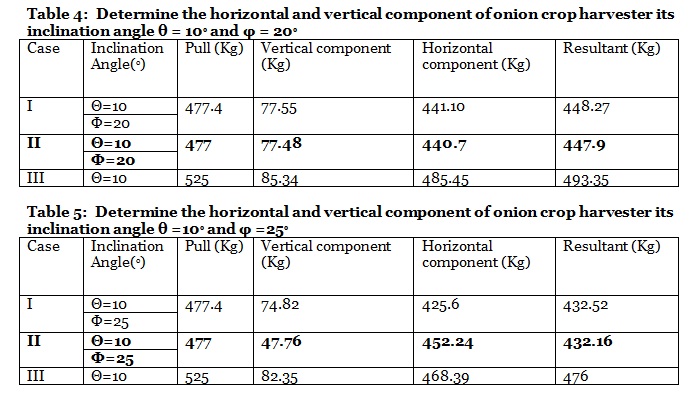Title: DESIGN OF ONION HARVESTER
Authors: Ashwini Talokar, Kanchan Wankhade, 4th Year, Agricultural Engineering department
Guide: V. P. Khambalkar, Asst.Professor, Agricultural Engineering department
College: College of Agricultural Engineering & Technology, Dr. Panjabrao Deshmukh Krishi Vidyapeeth, Akola.
Abstract:
The present research work has been carried out to bring out the reliable solution for harvesting of onion crop. The harvesting of onion crop is the labour intensive operation. The attempt has been made to design the harvester for the low power capacity tractors range in the 15 to 20 hp. The size of the harvester has been decided with respect to the agro technical features of the crop. The working width of the harvester has been worked out to be 60 cm. The depth of operation for the onion crop has been decided up to 10 cm. The width and depth ratio was comes to 6:1 which is fit to the design. The soil mass load on the harvester was worked out to be 1.35 N/cm2. The volume of soil discharge per second on the web has been estimated to be 0.023 m3/sec for the travel speed of 3.0 km/h. The total capacity of the harvester in respect of the working in the soil has worked out to be 104 tones/hr. accordingly the materials for the fabrication has been decided as per the BIS standard. The PTO power requirement for effective working of the harvester has been optimize from the travel speed, the total soil load and the discharge of soil mass and the capacity of soil to be work. The estimated power requirement for the onion harvester is comes to 11 to 13 hp. The estimate forces on blade of horizontal has 440.7and vertical has77.48.Bending moment of blade and onion crop harvester is safely for the working of black cotton soil. The total weight of the machine was calculated as per the proposed engineering drawing comes to be 44.38 kg. The estimated cost of the onion harvester was worked out to be Rs. 7354
Keywords: Harvesting, soil load, power requirement, forces, tensile strength, engineering components of harvester, economic
Introduction:
Onion is the most important crop in India. The harvesting of onion crop is rigorous and requires huge amount of manpower and time. One of the main reasons of low productivity is insufficient power availability on the farm and low level of farm mechanization. This is especially true for India. The package of modern technology, improved seed and fertilizers, use of efficient and economical farm implements, machines and suitable form of farm power is very important. Production suffers because of improper seed bed preparation, delay in sowing and harvesting. Mechanization enables the conservation of input through precision metering, insuring better distribution, reducing quantity needed for better response and prevention of losses or wastage of inputs applied. Mechanization reduces unit cost of production through higher productivity.
Harvesting depends on its type and purpose such as greens, immature bulb & mature bulb. Optimum time of harvesting is one week after 50% of leaves have fallen. Maturities symptoms include yellowing of leave and dry at the top; bulbs turn red and attain their optimum varietal size. Bulbs continue to grow even after the foliage has fallen down. Harvesting is done by pulling the bulbs. The main limitation is that, the onion harvesters are made parallel to each other. The tractor has to take a U-turn at the end of each pass. Thus tractor-turning area is called headland and remained undug. The length of headland is higher. This headland is harvest by the farmer most often by perpendicular passes to the raised beds and some time they harvest it manually by extending the raised beds to the field end. This required extra time especially in smaller field. To overcome the problem of harvesting of onion and to reduce the cost of operation, the attempt has been made to design the harvester.
Material and methods:
Agro technical requirements:- The different varieties (Akola Safed, Pusa White Flat, Phule Safed , Basvant 780 , Phule Suvarna , Pusa Red , N-2-4-1 etc.) of onion are grown in Vidharbha region of the Maharashtra state. The physical characteristics of some important varieties of onion had been studied for various observations like bulb diameter, crop depth, number of branches, height of crop from ground and approximate average plant canopy at the time of harvesting of the crop having 10 x10 cm row to row spacing. The agro technical data for different varieties collected from field of All India Co-ordinated Research Project on onion, Dr. PDKV, Akola. The vernier caliper scale, tape etc were used for taking above mentioned observation (Fig:1).
Design component of onion harvester
Main frame
Main frame consists of a rectangular square section which was made by welding two M. S. angles of size 102 x 60 cm having length 102 cm.
A hitching arrangement was provided at the top of square section of main frame and adjustment was so made that, three bar linkage could be easily hitched to the frame.
Blade
Design of blade MS flat was taken having shear stress and 150 kg/cm2 and 450 kg/cm2 respectively. The mild steel flat having thickness of 10 mm was use to overcome the problem of bending and breaking concave use for harvesting onion. The overall working width and the depth of operation for the cutting blade as per the calculation of power requirement have been consider as 60 cm and 10 cm respectively.
Web
Web where round steel rods of 11.1 to 12.7 mm diameter the total length of the 795 mm. The web is welded to the frame at the two positions and web outside of frame is 75mm.
Blade is inner side connected to the web at distance 25.4mm and after distance increases end of web connected to frame at distance 44.4mm. The spacing between the web from which cut soil and the onion bulb is going to pass is taken as 25 mm to 44 mm as per the polar and equator diameter of the onion bulb.
Determination of soil load on harvester
The soil load of the harvest including the onion bulb on the cutting unit and the windrowing unit i.e., web has been determined from the various factors. The overall impact of the soil load has been calculated from the cress section area of soil to be cut and the density of soil. Similarly, the weight of onion bulb has been considered with respect to the spacing between crop row and the plant. The instantaneous movement of soil on the harvester web has been over the forwarding speed of the tractor for 2.5, 3.0 and 3.5 km/h.
Determination of power
The effective working of the harvester is purely depends on the fulfillment of the draft requirement. The soil resistance for the region has been taken into account for determining the power requirement of the machine. The power requirement has been determined for the various working speed of the tractors (mini tractor).
Bending moment of onion crop harvester:-
Bending moment is such that it tends to bend the implement at that point to a curvature having a concavity of two positions positive and negative. The positive bending moment is called sagging moment and negative is called hogging moment.
Bending moment of blade:-
Deflection of onion crop harvester
Case I) Deflection of onion crop harvester blade
We know that maximum slop occurs at the free end therefore for maximum slope substituting x = 0 in equation wl3
W = load on blade
E = Youngs modulus (kg/cm4)
I = moment of inertia
Case II) Deflection of the steel bar of onion crop harvester
We know that maximum slope occurs at the free end therefore for maximum slope substituting x = 0 in equation wl3
Forces act on onion crop harvester of blade
1) Force of gravity
2) Soil reaction on the onion harvested blade
If θ is angle of inclination of force P in the vertical plane with the horizontal surface and φ is angle of inclination of P in the transverse plane with the horizontal direction.
L = P Cos θ Cos φ
V = P Sin θ Cos φ
R = P Cos φ
Where
L = horizontal component (Kg)
V = vertical component (Kg)
R = Resultant force (Kg)
P = pulling force (kg)
Result and Discussion
Determination of soil load on harvester
The density of the soil for the RUGUR or black cotton soil has been consider in the range from the literature is 1.16 to 1.28 g/cm2 (low and high) and average density of soil is taken in calculation..
Mass of onion bulb
The average plant to plant spacing from the observation was 10 cm and row to row spacing has been considered in the range of 10 to 15 cm.
Consider, Four rows of onions
Each row contains 10 onions
Therefore, Total numbers of onions in four rows = 10 × 4 = 40.
Total weight of the onions in four rows (kg) = 40 × 100 = 4.00 kg.
Total weight of the onions in four rows (N) = 4 × 9.8
Total weight of the onions in four rows = 39.20 N.
We have,
The total soil load considering the volume/mass of soil (1.21N/cm2) and the load of onion bulb (0.133 N/cm²) was 1.35 N/cm².The determined load on the harvester is helpful for selection of appropriate materials for it construction. The overall working of the designed harvester is depicted in fig 2.
Path of soil and onion bulb movement
Case (I) Soil movement for travel speed of 2.5 km/h
Case (II) Soil movement for travel speed of 3.0 km/h
Case (III) Soil movement for travel speed of 3.5 km/h
Power for harvester
We have,
Soil Resistance for black cotton soil = 0.79 kg/cm².
Forward speed of the Tractor (I) 2.50 km/h.
(II) 3.00 km /h.
(III) 3.50 km/h.
Bending moment of onion crop harvester:
Case I) Bending moment of blade:-
Shear force
= – (40.57 x 0.3) = – 12.171 kg
Bending moment
= – 1.82 kg m
Deflection of onion crop harvester blade
IB = 9.34 x 10-9 radian
Bending Moment of implement of onion crop harvester:-
Shear force= = -41.38 kg
Bending moment = -21.10 kg-m
Deflection of onion crop harvester = 8.255 x10-6 radian
Slope of the implement = 1.07x 10-7 radian
The bill of materials
Summary
The project entitled “Design of onion crop harvester” has been taken to reduce the gap of mechanization. The designed harvester is surely helpful to harvest the onion bulb effectively. The design of the onion harvester was greatly depend on the working width, depth of operation and the conveying capacity. The agro technical data of the crop has been collected from the university field regarding the depth of onion bulb, spacing between plant and row to row distance, height of crop, polar and equator dimension of the onion bulb. The overall size of the harvester is 1020 x 600 x 300 mm. The width to depth ratio for optimum operation performance is chosen and comes to be 6:1. The depth of operation according to the agro-technical requirement was comes to be 10 cm. The working width of the machine with respect to the power availability and the crop sowing characteristics is comes to be 60 cm.
Conclusion
- The soil load on the harvester is comes to be 1.35 N/cm2 for the speed of 3 km/h.
- The movement of soil in relation to the path, the discharge volume of the soil mass was observed to be 0.023 m3/sec.
- The soil working capacity of onion harvester is estimated to be 104 tonnes/h.
- The PTO power requirement of the harvester for the working speed of 3.0 km/h was estimated in the range of 11 to 13 hp.
- Bending moment of blade and onion harvester for the load was not take. Hence the for this capacity and discharge safely onion crop harvester.
- Forces act on implement for this power safely and 3km/h speed was vertical and horizontal safe working
References
Akinbamowo.R.o, A.S.Ogunlowo and L.A.S.Agbetoye (2011) Development of a tractor-mounted cocoyam (Xanthosoma spp.) harvester.AJAE 2(3):82-89.
Al-Jubouri K. A. J. and P. B.Mcnulity (1984) Potato Digging Using Orbital Vibration J. agric. Engng Res.29, 73-82
Bahnasawy.A.H , Z.A. El-Haddad, M.Y. El-Ansary and H.M. Sorour (2004) Physical and mechanical properties of some Egyptian onion cultivars, Journal of Food Engineering 62, 255–261.
Blahovec.J (2005) Impact induced mechanical damage of Agria potato tubers. RES. AGR. ENG., 51, (2): 39–43.
Ibrahim.M. M, Amin.E and A. Farag (2008) Development a multipurpose digger for harvesting root crops. Misr J. Ag. Eng., 25(4): 1225-1239.
Khurmi R.S. (2001) Tex book of Strength of material.
Morad, M. M,G. H. Elsaid, M. M. A. El-Sharabasy and F. A. Abd elgawad(2007) Comparitive study between manual method and mechanical method of harvesting sugar beet crop. Misr J. Ag. Eng., 24(4): 793-813

